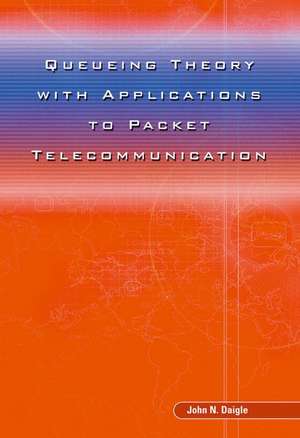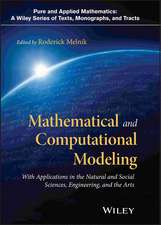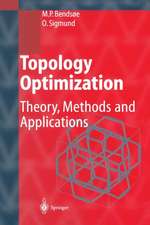Queueing Theory with Applications to Packet Telecommunication
Autor John Daigleen Limba Engleză Hardback – 24 sep 2004
Key features of communication systems, such as correlation in packet arrival processes at IP switches and variability in service rates due to fading wireless links are introduced. Numerous exercises embedded within the text and problems at the end of certain chapters that integrate lessons learned across multiple sections are also included. In all cases, including systems having priority, developments lead to procedures or formulae that yield numerical results from which sensitivity of queueing behavior to parameter variation can be explored. In several cases multiple approaches to computing distributions are presented.
Queueing Theory with Applications to Packet Telecommunication is intended both for self study and for use as a primary text in graduate courses in queueing theory in electrical engineering, computer science, operations research, and mathematics. Professionals will also find this work invaluable because the author discusses applications such as statistical multiplexing, IP switch design, and wireless communication systems. In addition, numerous modeling issues, such as the suitability of Erlang-k and Pade approximations are addressed.
| Toate formatele și edițiile | Preț | Express |
|---|---|---|
| Paperback (1) | 641.85 lei 43-57 zile | |
| Springer Us – 29 oct 2010 | 641.85 lei 43-57 zile | |
| Hardback (1) | 649.22 lei 43-57 zile | |
| Springer Us – 24 sep 2004 | 649.22 lei 43-57 zile |
Preț: 649.22 lei
Preț vechi: 763.78 lei
-15% Nou
Puncte Express: 974
Preț estimativ în valută:
124.27€ • 135.03$ • 104.45£
124.27€ • 135.03$ • 104.45£
Carte tipărită la comandă
Livrare economică 21 aprilie-05 mai
Preluare comenzi: 021 569.72.76
Specificații
ISBN-13: 9780387228570
ISBN-10: 0387228578
Pagini: 316
Ilustrații: XXIII, 316 p.
Dimensiuni: 155 x 235 x 23 mm
Greutate: 0.66 kg
Ediția:2005
Editura: Springer Us
Colecția Springer
Locul publicării:New York, NY, United States
ISBN-10: 0387228578
Pagini: 316
Ilustrații: XXIII, 316 p.
Dimensiuni: 155 x 235 x 23 mm
Greutate: 0.66 kg
Ediția:2005
Editura: Springer Us
Colecția Springer
Locul publicării:New York, NY, United States
Public țintă
Professional/practitionerCuprins
Terminology and Examples.- Review of Random Processes.- Elementary Continuous-Time Markov Chain-Based Queueing Models.- Advanced Continuous-Time Markov Chain-Based Queueing Models.- The Basic M/G/1 Queueing System.- The M/G/1 Queueing System with Priority.- Vector Markov Chain Analysis: The M/G/1 and G/M/1 Paradigms.- Closing Remarks.
Textul de pe ultima copertă
Queueing Theory with Applications to Packet Telecommunication is an efficient introduction to fundamental concepts and principles underlying the behavior of queueing systems and its application to the design of packet-oriented electrical
communication systems. In addition to techniques and approaches found in earlier works, the author presents a thoroughly modern computational approach based on Schur decomposition. This approach facilitates solution of broad classes of problems wherein a number of practical modeling issues may be explored.
Key features of communication systems, such as correlation in packet arrival processes at IP switches and variability in service rates due to fading wireless links are
introduced. Numerous exercises embedded within the text and problems at the end of certain chapters that integrate lessons learned across multiple sections are also included. In all cases, including systems having priority, developments lead to procedures or formulae that yield numerical results from which sensitivity of queueing behavior to
parameter variation can be explored. In several cases multiple approaches to computing distributions are presented.
Queueing Theory with Applications to Packet Telecommunication is intended both for self study and for use as a primary text in graduate courses in queueing theory in electrical engineering, computer science, operations research, and mathematics. Professionals will also find this work invaluable because the author discusses applications such as statistical multiplexing, IP switch design, and wireless communication systems. In addition, numerous modeling issues, such as the suitability of Erlang-k and Pade approximations are addressed.
communication systems. In addition to techniques and approaches found in earlier works, the author presents a thoroughly modern computational approach based on Schur decomposition. This approach facilitates solution of broad classes of problems wherein a number of practical modeling issues may be explored.
Key features of communication systems, such as correlation in packet arrival processes at IP switches and variability in service rates due to fading wireless links are
introduced. Numerous exercises embedded within the text and problems at the end of certain chapters that integrate lessons learned across multiple sections are also included. In all cases, including systems having priority, developments lead to procedures or formulae that yield numerical results from which sensitivity of queueing behavior to
parameter variation can be explored. In several cases multiple approaches to computing distributions are presented.
Queueing Theory with Applications to Packet Telecommunication is intended both for self study and for use as a primary text in graduate courses in queueing theory in electrical engineering, computer science, operations research, and mathematics. Professionals will also find this work invaluable because the author discusses applications such as statistical multiplexing, IP switch design, and wireless communication systems. In addition, numerous modeling issues, such as the suitability of Erlang-k and Pade approximations are addressed.
Caracteristici
Emphasis on packet communications used in wireless and network engineering Includes supplementary material: sn.pub/extras















